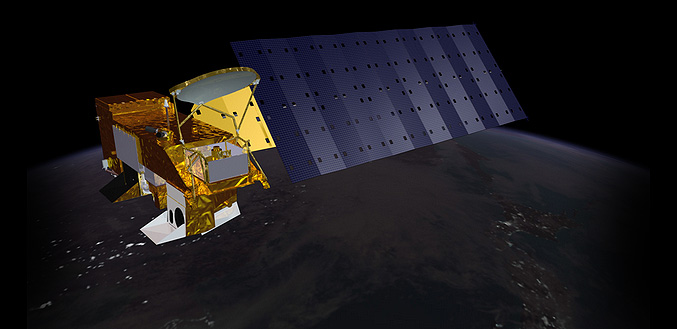
- INFORMATION
AQUA

Aqua (EOS PM-1) is a multi-national NASA scientific research satellite in orbit around the Earth, studying the precipitation, evaporation, and cycling of water. It is the second major component of the Earth Observing System (EOS) preceded by Terra (launched 1999) and followed by Aura (launched 2004).
The name "Aqua" comes from the Latin word for water. The satellite was launched from Vandenberg Air Force Base on May 4, 2002, aboard a Delta II rocket. Aqua is on a Sun-synchronous orbit. It flies leading the satellite formation called the "A Train" with several other satellites (Aura, CALIPSO, CloudSat and the French PARASOL).
Aqua carries six state-of-the-art instruments in a near-polar low-Earth orbit. The six instruments are the Atmospheric Infrared Sounder (AIRS), the Advanced Microwave Sounding Unit (AMSU-A), the Humidity Sounder for Brazil (HSB), the Advanced Microwave Scanning Radiometer for EOS (AMSR-E), the Moderate-Resolution Imaging Spectroradiometer (MODIS), and Clouds and the Earth's Radiant Energy System (CERES). Each has unique characteristics and capabilities, and all six serve together to form a powerful package for Earth observations.
The name "Aqua" comes from the Latin word for water. The satellite was launched from Vandenberg Air Force Base on May 4, 2002, aboard a Delta II rocket. Aqua is on a Sun-synchronous orbit. It flies leading the satellite formation called the "A Train" with several other satellites (Aura, CALIPSO, CloudSat and the French PARASOL).
Aqua carries six state-of-the-art instruments in a near-polar low-Earth orbit. The six instruments are the Atmospheric Infrared Sounder (AIRS), the Advanced Microwave Sounding Unit (AMSU-A), the Humidity Sounder for Brazil (HSB), the Advanced Microwave Scanning Radiometer for EOS (AMSR-E), the Moderate-Resolution Imaging Spectroradiometer (MODIS), and Clouds and the Earth's Radiant Energy System (CERES). Each has unique characteristics and capabilities, and all six serve together to form a powerful package for Earth observations.
- AMSR-E
The Advanced Microwave Scanning Radiometer for EOS (AMSR-E) is a twelve-channel, six-frequency, total power passive-microwave radiometer system. It measures brightness temperatures at 6.925, 10.65, 18.7, 23.8, 36.5, and 89.0 GHz. Vertically and horizontally polarized measurements are taken at all channels. The Earth-emitted microwave radiation is collected by an offset parabolic reflector 1.6 meters in diameter that scans across the Earth along an imaginary conical surface, maintaining a constant Earth incidence angle of 55° and providing a swath width array of six feedhorns which then carry the radiation to radiometers for measurement. Calibration is accomplished with observations of cosmic background radiation and an on-board warm target. Spatial resolution of the individual measurements varies from 5.4 km at 89.0 GHz to 56 km at 6.9 GHz.
- MODIS
The Moderate Resolution Imaging Spectroradiometer (MODIS), is a 36-band spectroradiometer measuring visible and infrared radiation and obtaining data that are being used to derive products ranging from vegetation, land surface cover, and ocean chlorophyll fluorescence to cloud and aerosol properties, fire occurrence, snow cover on the land, and sea ice cover on the oceans. The first MODIS instrument was launched on board the Terra satellite in December 1999, and the second was launched on Aqua in May 2002.
- AMSU-A
The Advanced Microwave Sounding Unit (AMSU-A), a 15-channel microwave sounder designed primarily to obtain temperature profiles in the upper atmosphere (especially the stratosphere) and to provide a cloud-filtering capability for tropospheric temperature observations. The first AMSU was launched in May 1998 on board the National Oceanic and Atmospheric Administration's (NOAA's) NOAA 15 satellite. The EOS AMSU-A is part of a closely coupled triplet of instruments that include the AIRS and HSB.
- AIRS
The Atmospheric Infrared Sounder (AIRS), an advanced sounder containing 2378 infrared channels and four visible/near-infrared channels, aimed at obtaining highly accurate temperature profiles within the atmosphere plus a variety of additional Earth/atmosphere products. AIRS will be the highlighted instrument in the AIRS/AMSU-A/HSB triplet centered on measuring accurate temperature and humidity profiles throughout the atmosphere.
- HSB
The Humidity Sounder for Brazil (HSB), a 4-channel microwave sounder provided by Brazil aimed at obtaining humidity profiles throughout the atmosphere. The HSB is the instrument in the AIRS/AMSU-A/HSB triplet that allows humidity measurements even under conditions of heavy cloudiness and haze. The HSB provided high quality data until February 2003.
- CERES
The Cloud's and the Earth's Radiant Energy System (CERES) is a 3-channel radiometer measuring reflected solar radiation in the 0.3-5 µm wavelength band, emitted terrestrial radiation in the 8-12 µm band, and total radiation from 0.3 µm to beyond 100 µm. These data are being used to measure the Earth's total thermal radiation budget, and, in combination with MODIS data, detailed information about clouds. The first CERES instrument was launched on the Tropical Rainfall Measuring Mission (TRMM) satellite in November 1997; the second and third CERES instuments were launched on the Terra satellite in December 1999; and the fourth and fifth CERES instruments are on board the Aqua satellite.
Referred by NASA(http://aqua.nasa.gov) website
Referred by NASA(http://aqua.nasa.gov) website


